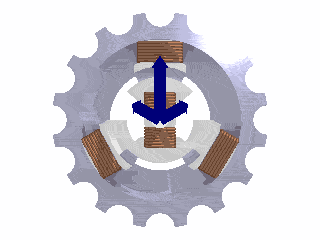AC and DC
When the current is in one direction only, we call it direct current DC; and when the ‘shoves’ are in one direction and then the other, back and forth like a swing, we call it alternating current or AC.

Both carry usable energy but AC makes less efficient use of the conductor as there are two points each cycle when nothing is happening and high currents, and greater loss, happens at the peaks.
So how do we make electrical currents flow?
If we want to carry energy along a conductor, we need to stimulate electrons to start passing it on as one shove to the next; in the desired direction.
By far the most common way of doing this is by passing a conductive wire through a magnetic field; or a passing a magnetic field across a wire. This gives the electrons a shove along the axis of the wire. The field has to be moving relative to the wire. A stationary field like the Earth's magnetic field requires the wire to be moving.
You have probably tried to push the matching poles of two magnets together. In the same way a magnet pushes the electrons along a wire. This push-back becomes stronger if we resist the current by putting it to use in a circuit; for example: to heat a wire or make another magnet move in a motor.
It is quite easy to make a coil of wire into an electro-magnet. This can be as strong as most magnets you might have played with.
This is how the alternator in your car makes electricity to charge the battery. It has a whole bunch of wires (usually end to end in a coil) and every turn of the shaft rotates these wires through a magnetic field. The effort required to do this is in direct relation to the energy required to charge the battery.
Most electrical generators work on this simple principle. It very efficiently turns mechanical energy into electricity; or back again to mechanical energy in an electric motor. Read More...
It's quite easy (as a child) to make one yourself and run it with a toy 'donkey engine' to light a light bulb.

3 Phase Alternator Operation (the rotating bit here can be a permanent magnet)
source: Wikipedia
Water pressure can be used to rotate the shaft of an alternator (an AC generator) below a dam.

Steam is used to drive a turbo-alternator in a coal, gas, geothermal or nuclear power-station. Petrol oil or gas engines; or wind can be used to rotate the shaft of an alternator; and tides, currents and waves drive machines to do the same thing.
There are many images of various types of power generation elsewhere on this website.
Other ways of making currents
But we can also get currents moving in other, harder to understand, ways.
A photovoltaic solar cell exploits the ability of semiconductors to allow electrons to move in one direction only. If these are then excited by energy from photons (a type of boson), they get pumped along specially designed current paths in one direction only.
This is oversimplifying a phenomenon requiring knowledge of depletion layers, electron tunnelling, and even quantum mechanics for a full explanation. You need to know a bit about semiconductors. Read More...
Photovoltaic solar cells are still in development and a lot of work is going into improving their conversion efficiency and bringing down their cost.
It is hoped that soon they will be able to provide up to 20% of our energy requirements; possibly more if we can find an economical way of storing energy from day to night and season to season.
Thermocouples employ the flow of heat in a metal from a hot area to a cold one called the Seebeck effect. Electrons in the hotter areas are more energetic than in the cooler part causing a voltage gradient. Electrons flow at different rates in different metals so if two dissimilar metals are in electrical contact near the source of heat the net difference in voltage gradient (in response to the same heat gradient) will result in a current flowing from one metal to the other.
Thus some of the heat flowing from hot to cold is converted to electricity. This is what is helping to power the recent Mars Lander: Curiosity. It uses decaying plutonium to provide the heat to thermocouples. These provide base load energy at night when Mars is very cold. Curiosity also has solar panels.
Despite maximising the differential by using very different metal alloys, the conversion efficiency of heat to electricity is still relatively poor. But efficiency is a secondary issue if the energy source is plentiful and free. The biggest issue preventing this source being used back here on earth is the equipment cost: how much energy is converted per dollar of device? Using that criterion, it's very expensive electricity indeed.
Efficiency does have an impact on physical size. This may be important is space is limited. This becomes evident when we calculate how big an area of solar panels some industries might need.
For example, an aluminium smelter would need many square kilometres of solar panels (around 30 million present generation commercial panels) to supply the electricity required to separate the metal from alumina. This would not be feasible anyway as the aluminium pots can't be shut-down overnight or on dull days.
Electricity can also be produced by ion exchange. This is the way batteries and fuel cells work.
As already mentioned, ions are negatively or positively charged atoms. These can be caused to flow by chemical and sometimes physical means.
For example, changing ion concentrations across a barrier, through which only some ions can pass (osmosis), is used very widely in nature. This happens in our body cells to produce nerve signals and; in the case of some eels, produces thousands of volts. Read More...
